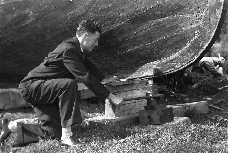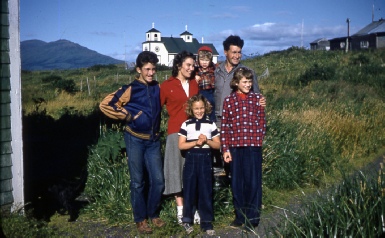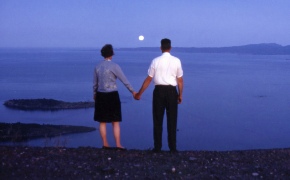Evangel Island Journey - Author's Introduction (revised/updated 2019)

These web articles were written by Timothy Smith, son of Rev. Norman and Joyce Smith,
who ran the Baptist mission boat Evangel from the early 1950’s to the mid-1960’s,
around Kodiak Island, Alaska. Some of these articles have been online since 1999
when this site began.
These are my introductory notes and personal comments, to guide you on your journey
with the Evangel.
Right: the new logo for the series. The Evangel is at the dock in Ouzinkie, its home
base from 1958 to 1964. The photo was taken in 1961. Click on the photo to go back
to the index.
My name is Timothy Smith, fourth child of Rev. Norman and Joyce Smith, who moved
with their family to Alaska in the spring of 1952. I was born in the Territory of
Alaska the following spring. As a young child, I learned to walk on board a small
boat called the Evangel as it traveled from village to village, cannery to cannery
around Kodiak Island in the Gulf of Alaska. The boat was my summer home. As the child
of missionaries who operated an unusual mission boat in a spectacular mission field,
I had many unforgettable experiences, often just in trying to get from one place
to another. Our adventures took place in the 50’s and 60’s, when Kodiak Island was
a remote, often hostile and always unpredictable place. The basic introduction to
the boat and the other articles is in this document, but then I hope you will move
on around the Kodiak Island area using the article link in the photo above, for a
unique Kodiak Island journey featuring photos and tales of the travels of the Evangel.
The reader needs to understand that the web articles that follow were written by
a man in his fifties, but the memories are those of a child, not an adult. Of course
there is perspective and the long view of experience. But I was not an adult in the
50’s and early 60’s, and so I do not know whether the actions and attitudes of the
adults around me would be the same as what might be done today. I do know, however,
that when I look back at those days, how I lived and what I was accustomed to, it
makes me shake my head in wonderment. It was a frequently exciting, usually dangerous,
back breaking, tough kind of existence. But it was also a life our family shared
in common with all the other rural residents of the Kodiak Island area, so naturally,
I regarded it as normal. I won't quibble about particulars or speculate much about
how I would react to those things now. As a young child, I lived without running
water or regular electricity, rarely used a bathtub, had hand-me-down clothes, regularly
ate freshly-butchered Kodiak bear or seal or porpoise (and other more popular northern
fare like salmon), and thought all of it perfectly normal. I also somehow knew I
was living a wonderful childhood in a completely spectacular part of the world, and
that I was not living it from a discreet distance, but immersed in it.
The element of faith is also not to be missed or glossed over in these short articles.
True, I was a Baptist missionaries’ kid, but that doesn't explain everything. I suppose
it would be possible to have done all those things and traveled to all those places
without a sense of the hand of God, but I certainly felt Him. Just the words to all
the hymns we sang would have seen to that! And looking back as an adult, I see God’s
hand at work, but in a much different way than I would have been able to see as a
child. Yes, I spent the first twelve years of my life traveling around some islands
in Alaska on a mission boat. But the boat, of course, is not the hero of this story,
and neither am I. The articles are not an official biography of my parents, either.
And these articles are definitely not written to sound like missionary support letters
or magazine travelogues. I am simply telling a story, and when the kind of work my
parents were doing is part of the story, it will be included as naturally as will
any of the other elements. It is my intention to simply share some of the adventures
we had, publish some of my dad’s spectacular photos from an era that is long gone,
jog a few memories, and maybe let the mission of that little boat and its crew inspire
a few people. (Continues below…)
Photos of the Evangel’s Early Years (1949 - 1951)




The Evangel was built from a Navy buoy tender (see above photo for similar hull design)
and completed in 1949. The Baptist newsletter (left) indicates the qualifications
needed to be its captain. The Chandlers from Washington took the job for a couple
of years. Norman Smith helped in 1951, then moved to Alaska to take the helm permanently
in 1952.
Norm Smith put in a new Lathrop marine engine, and re-launched the Evangel. He and
Joyce and family served one summer, then moved to Alaska in 1952.
Left: Norman Smith prepares to launch the Evangel after replacing its engine. Right:
The boat is tied up (near where City Dock is now) in Kodiak shortly after re-launch.
All of the journeys recounted in this series of web articles were taken aboard a
39-foot, 25-ton motor boat, underpowered and slow, low in the water, and yet surprisingly
seaworthy and reasonably comfortable. The Evangel was a mission boat that operated
for fifteen years (1949 to 1964) in the waters around Kodiak Island. The Evangel
was owned by the American Baptists, who have also managed the Kodiak Baptist Mission
since the 1890’s. The boat was built in the late 1940’s using a surplus Navy buoy
tender hull and an efficient, if somewhat ungainly superstructure constructed by
Ted Williams and his son Roger. It was piloted for the first couple of years by Glenn
Chandler, and later by Norman and Joyce Smith and family. In the 1970’s the boat
was personally owned by Norman and Joyce, and restored sufficiently well (with a
new Isuzu diesel engine) for over five more years of service. Its last known run
under its own power was a trip to Ouzinkie and back to Kodiak in 1979, with my brother
Kelly at the wheel. It later languished in the small boat harbor at Kodiak (due to
my father’s ill health) until it was moved as a derelict to a dry dock area near
the Coast Guard base. It was later moved to a plot of land in the Monashka Bay area
near Kodiak in the 1990’s, where it was converted to a privately-run museum. It has
been extensively modified to house a private museum collection. These web articles
are a more fitting memorial.
The Evangel could hold folding chairs, a portable pump organ, filmstrip projector,
record player and records, movie projector, children’s crafts and curriculum, hymnbooks,
Bibles and stationery supplies in addition to its full complement of nautical gear.
It had dual power sources (triple, if you count its hookup to city power while in
port): full wiring throughout for 12-volt DC battery lighting and for standard 110
volt AC, when the portable generator was cranked up to run the projector or the record
player. (Two sets of light bulbs everywhere). The Evangel floated so low in the water
that it was not at all unusual for sea water to splash in the side windows in a good
side swell, because the side windows were only a few feet above the waterline. If
you sat on the mats that served as side benches and sleeping pads, and happened to
look out the windows, it was a bit unnerving at first to realize that most of your
body was below the waterline, and that the waves outside were often above eye level.
But in years of facing some of the worst seas, the Evangel proved itself a worthy
sea boat, and served us dependably and with some measure of comfort during the many
years of her service.
Every summer during the seasons it was in operation, the Evangel would make several
trips around Kodiak Island. There was never a “typical” trip, because we always stopped
where there were people, and some locations were so remote and so sparsely populated
that we weren’t able to get there very often. There was usually a north-end trip
and a south-end trip, terminating in Kodiak, timed so that the summer camps near
there could begin and end with the Evangel providing transportation. The villages
and canneries that were regularly visited in the south end (Larsen Bay was our home
port for the first six years) included Village Islands, Akhiok, Alitak (Lazy Bay)
cannery, Karluk, Kaguyak, Shearwater cannery, San Juan cannery, Parks cannery and
Old Harbor. We would also stop at the mothballed Zachar Bay cannery, Harvester Island
and Port Hobron, an abandoned whaling station, as well as several bear camps, if
we knew there was anyone home at the time. The north-end trip usually included Ouzinkie
village (home base after 1957), Afognak village, Port Williams cannery, Port Bailey
cannery, Port Vita cannery (if anyone was home), a sawmill or two and Wakefield's
cannery and village on Raspberry Island. Our season would commence once school let
out in early May, and end with another set of journeys from August until school started
in September. Both weather and insurance kept us mostly port-bound all winter.
A Concluding Thought:
The Evangel was an odd-looking craft in a sea of fishing boats, looking like “Tuffy
the Tugboat’s” long-lost cousin. Yet the boat came to be regarded with great affection
by the many people who traveled on her or visited her while she was tied up to some
cannery dock or anchored in the bay of some fishing village. But more importantly,
through the ministry of Rev. Norman and Joyce Smith aboard the Evangel, a great many
people came to hear and understand the Good News for the first time. I can’t tell
you their story; I can only tell you mine, from the perspective of a young boy growing
up in one of the most exciting times in some of the most interesting places.
During the camping season at Camp Woody, we typically divided our island journeys
in half, with Larsen Bay and Karluk as the farthest point on a north-end run, and
Akhiok and Lazy Bay as our farthest point on the south-end run. And depending on
our time available, we might not stop at every place each trip, but return later
to finish our itinerary. These half-trips around the island were made necessary by
the need to return to Woody Island to ferry the campers back home. We also spent
several weeks every summer on Woody Island, to work a couple of camps. For years,
the first camps were held the last week of June, even though the children of Kodiak
Island got out of school in early May, to leave the Evangel free for a month of uninterrupted
traveling. At the end of camping season, we sometimes had time for only one or two
short mission trips before we had to go back and get ready for the long winter: bringing
in supplies, making repairs to our land-based home, and winterizing both the camp
and the Evangel. For the sake of this simulated journey, we are making a complete
trip, as we used to do every May and June, with an extended stay (several articles)
at each of the two winter homes: Larsen Bay and Ouzinkie. (Continues below…)
Note on Sources of Photos and Accuracy of the Narrative
Most of the photos are from Dad's little Argus C3 slide camera or from one of his
Kodak 616 negatives, all of which he shot without a light meter! Dad’s old photos
are not all-inclusive or chronological, but all the shots he took are now historic
and irreplaceable. So these accounts offer a simulated series of journeys around
the Kodiak archipelago, to give a feel for the Evangel and its mission in those days.
It is “historical novel” in essence, with real people, typical events, but occasionally
re-arranged sequencing. I can’t tell you which days were spent in which port, or
things like that, but you’ll get an accurate feel of what it was like to be there
at the time. Details have been combined and adapted to flow in the narrative, or
simply because that’s how I remembered the situations. Therefore, this account is
vivid but imprecise, as good memories tend to be.
Photos of “Timmy” – My Spot In The Story




Top: “Timmy Smith” graces the cover of a Baptist missionary booklet. Right: The
Smith Family poses in Akhiok, 1956: Noel, Joyce, Norman holding me, Robin, Jerilynn
Left Photo: the Smith Family in Ouzinkie, our second home base, 1961: back - Robin,
Noel, Jerilynn. Front - Kelly (born 1959 in Kodiak), Norman, Joyce, Timmy. Right
Photo: Vacation Bible School at our old home base of Larsen Bay, 1961. “Timmy” is
front and center!

Left: a frame from a display for my parents’ 50th Anniversary in 1990 features the
actual “Christ Our Pilot” picture that had hung in the cabin of the Evangel, and
a wooden model of the Evangel carved by a local young man on Spruce Island.
Below: Joyce and Norman Smith, Pillar Mountain, 1971. Mab Boko photo.


Click the Evangel Logo for the next Article
To Find Out More About Tanignak.com, Click HERE
To Visit My “About Me” Page, Click HERE

To Get Back “Home”
Please Click on the Site Logo Below:

Information from this site can be used for non-commercial purposes with attribution.
The text of all the articles on Tanignak.com and TruthTexts.com are copyright 2020
by Timothy L. Smith (see the “About Tanignak.com” link). The photographs are copyright
the estate of Rev. Norman L. Smith, or are copyright Timothy L. Smith unless otherwise
attributed. Many thanks to the people who have shared their stories and those who
have allowed me to use their photographs on Tanignak.com!

















